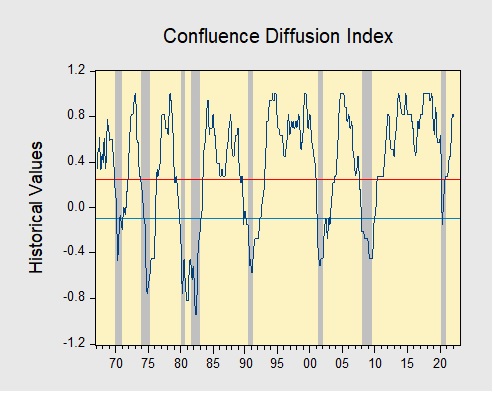Business Cycle Report (May 26, 2022)
by Thomas Wash | PDF
The business cycle has a major impact on financial markets; recessions usually accompany bear markets in equities. The intention of this report is to keep our readers apprised of the potential for recession, updated on a monthly basis. Although it isn’t the final word on our views about recession, it is part of our process in signaling the potential for a downturn.
The Confluence Diffusion Index hit a post-recession high; however, several indicators have deteriorated. In April, elevated inflation and hawkish Fed policy weighed on financial market indicators, leading to a flatter yield curve and a deceleration in the annual change in the stock market index. In the labor market, indicators show firms are reluctant to lay off workers because of concerns of a worker shortage. Lastly, manufacturing and construction indicators suggest that supply chains are still a problem for firms. Consequently, the latest report showed that all 11 benchmarks are in expansion territory. The diffusion index rose from +0.8789 to +0.9394, remaining well above the recession signal of +0.2500.
The chart above shows the Confluence Diffusion Index. It uses a three-month moving average of 11 leading indicators to track the state of the business cycle. The red line signals when the business cycle is headed toward a contraction, while the blue line signals when the business cycle is in recovery. The diffusion index currently provides about six months of lead time for a contraction and five months of lead time for recovery. Continue reading for an in-depth understanding of how the indicators are performing. At the end of the report, the Glossary of Charts describes each chart and its measures. In addition, a chart title listed in red indicates that the index is signaling recession.



